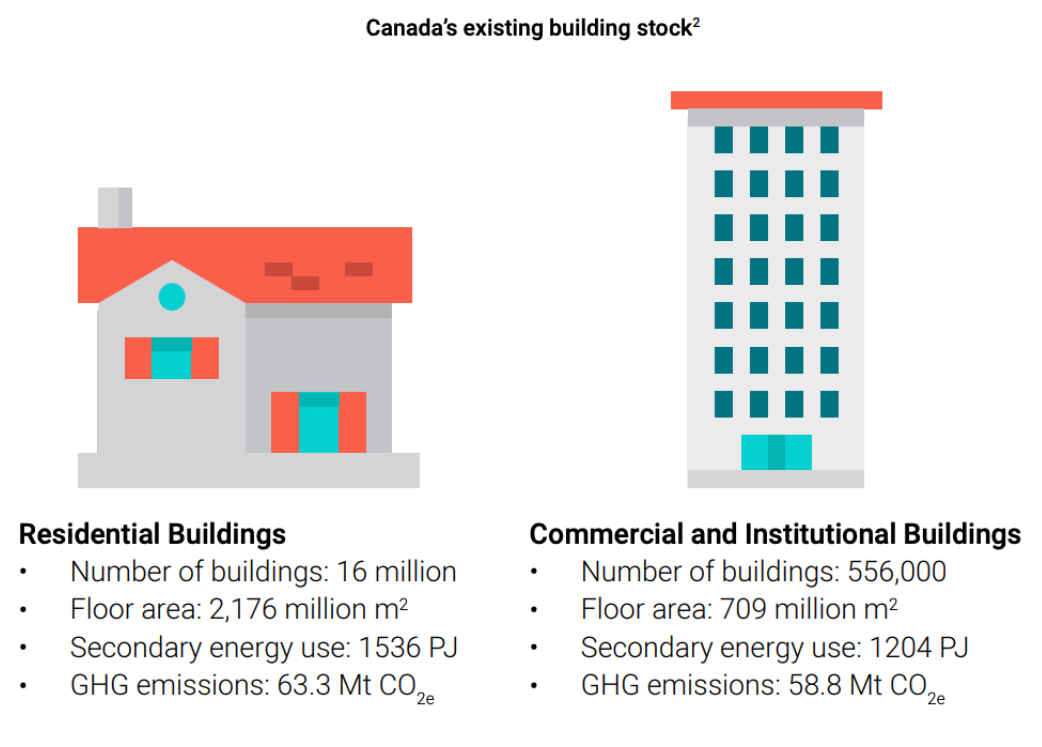Leading the Way
How municipalities can leverage benchmarking to building labeling to decarbonize existing buildings
Kevin Lockhart
Director of Buildings Research

Emilie Grenier
Engagement Manager
October 11, 2024
Blogs | Buildings | News
- Municipalities are seeking ways to limit emissions from their building sector.
- To do so, tools like benchmarking and building labelling, audits and recommissioning, or building performance standards are available.
- Ambitious communities are leading the way, and there are many tools to help your municipality embark on your building performance journey.
Existing buildings are where the emissions are at
Since 2000, the total emissions per unit floor area in Canadian buildings have decreased by about a quarter—this is good news. Overall, however, there has been a slight uptick in building sector emissions since 2005. This is mainly due to the increase in the total number of buildings; we’ve added about a quarter of today’s residential and commercial units over that time.
This speaks to the need for stringent standards on newly constructed buildings, namely the net zero energy-ready standard that is now baked into the 2020 national model codes’ top tier. As far as new buildings go, we can follow the adage—when you are in a hole, the first thing you need to do is stop digging. Provincial and municipal governments must work together to set clear timelines to reach the top tiers by 2030.
That’s a fairly straightforward path for new buildings, but what about existing buildings? To meet our 2030 and 2050 goals, most existing buildings must undergo low-energy, low-carbon retrofits. The first step will be to identify how different segments of existing buildings perform and then to provide targeted policies and programs to ensure they are on a path to net zero.
Residential and commercial buildings each have unique challenges. Targeting the commercial building sector first is an effective and cost-efficient strategy for reducing emissions. Canada has just over 500,000 commercial buildings, compared to roughly 16 million residential ones. Still, they account for 44 per cent of secondary energy use and total emissions in the building sector.

Addressing energy use and emissions from existing commercial buildings is a priority for all levels of government and is an area ripe for new or updated policy measures. We are already seeing some municipalities take steps toward commercial building decarbonization, using policy tools such as benchmarking, auditing/recommissioning requirements, and Building Performance Standards (BPS).
We will need their peers to join them in genuinely addressing the scale of the challenge. This will become easier as perceived obstacles, like those related to implementation or jurisdiction or concerns about the impact of building retrofits on affordability and equity, are resolved.
Benchmarking and beyond
Building energy use benchmarking and labelling policies are stepping stones towards net zero and are essential to setting existing buildings on a path of energy efficiency and reduced emissions. Benchmarking programs encourage or require building owners to track and report their energy, emissions and water usage over time.
For instance, some municipalities have made it mandatory, such as Montreal, Vancouver, and Toronto, the latter of which are building on province-wide requirements for performance reporting through the Energy and Water Reporting Benchmark (EWRB) program. There are also numerous voluntary initiatives across Canada, such as Benchmark B.C. and municipal efforts in Edmonton, Winnipeg, Ottawa, and Durham (which is notable as the first regional benchmarking program).
While benchmarking has numerous benefits, three key advantages make it a crucial first step toward more comprehensive efforts to decarbonize existing buildings.
- Building benchmarking provides insight into how the building stock is currently performing, identifying areas or segments of the market most in need of intervention. It also informs other policy areas, such as building codes, building performance standards, or supportive programs or incentives.
- Building benchmarking initiatives can be co-developed with municipalities, building owners and industry groups. A collaborative approach can help to build trust among building owners and better support compliance by gathering valuable input and proactively addressing barriers or concerns. The program and the municipality benefit from a shared sense of partnership and support.
- Building benchmarking helps prepare stakeholders for upcoming regulations, which are often more rigorous than existing standards. This helps to normalize energy and emissions performance in the existing buildings segment and plays a vital role in lessening implementation issues or compliance with future standards.
Beyond benchmarking, some jurisdictions require building owners to report their data and adopt simple, cost-effective energy efficiency measures at set intervals every five or ten years. These policies involve activities like audits, tune-ups, and recommissioning, which provide continuing information about how existing buildings within the municipality are performing. They assess how buildings currently use energy and encourage owners and operators to make reasonable upgrades where feasible.
Municipalities can use this information to target support effectively and by auditors or tune-up specialists to develop profiles on equipment type, fuel source, efficiency, age, and condition. This data enables local governments to craft more effective policies and programs tailored to their jurisdiction’s specific needs and characteristics. The reporting can help municipalities justify moving forward with suggested upgrades to energy efficiency policies, programs and incentives, making it a win-win for everyone.
Building performance standards are a targeted approach
Mandatory Building Performance Standards (MBPS) include building benchmarking and labelling requirements and existing support for energy efficiency improvements. To date, these efforts have been largely voluntary. Voluntary measures are effective in raising awareness about building energy use and emissions but have yet to trigger the scale of retrofit activity required to meet our climate commitments.
MBPS are simply a regulatory framework designed to enhance energy efficiency and reduce emissions, particularly in the worst-performing buildings. They do so by establishing future limits or thresholds for minimum energy and emissions performance well in advance, giving building owners both time and flexibility (e.g., all at once or over time, at the building or portfolio level) to meet these requirements. The idea is to make the requirements and timelines precise so that owners can put a comprehensive retrofit plan in place to begin taking steps to comply with the program’s performance targets.
MBPS policies offer carrots and sticks to encourage building owners to take action. Building owners are offered various technical and financial supports to meet these targets. Some buildings, such as churches or heritage buildings, can apply for special accommodation. While carrots alone are effective in supporting compliance with standards, moderate fines help to discourage noncompliance and can be set proportional to the amount of carbon overage emitted. These are typically set near or below what the required retrofit for the owner would cost and should be considered as a last resort.
MBPS play an essential role in signalling to the community that retrofits are a municipal priority and that retrofit activity will be supported, offering building owners a clear path that will help them allocate capital in a way that ensures optimal building operations and find ways to avoid future costs and regulatory penalties. Additionally, MBPS can help ensure that no one is left behind. A well-designed MBPS policy ensures everyone benefits from better-performing buildings, especially vulnerable populations.
How your municipality can move forward
Developing these initiatives can seem challenging. Regulatory frameworks may seem too big to tackle, and political discourse may impede progress. Efficiency Canada has supported municipalities in advancing building benchmarking, labelling, and performance standards nationwide. We’ve noticed some successful strategies and taken notes.
Here are some of the critical success factors we hear from leading municipalities as they continue to look for ways to cut energy and emissions in existing buildings:
- Plan for an extended runway: In the lead-up to these programs, engage extensively with local building owners to ensure everyone understands the benefits of building benchmarking, labelling, and standards.
- Use benchmarking as a stepping stone: Municipalities have started their journey to mandatory initiatives by first garnering support for and participation in voluntary programs. Municipalities are granted a wide range of authority on issues related to climate change mitigation and adaptation. Because climate impact considerations are the basis for building benchmarking, labelling, and standards programs, they can leverage these powers to make progress on their climate targets.
While emissions reductions are one goal of an effective benchmarking program, those programs are also a step closer to a more robust performance standard to help with data collection and inform policy design. Build relationships through your voluntary benchmarking program while you seek the authority for mandatory benchmarking or mandatory building performance standards.
- Tackle the big question head-on: Implementing benchmarking, gathering data, and centring your programs around climate initiatives can make a strong and clear case for establishing municipal authority on this file with your province. Tackle the big question of authority head-on by meeting with your province’s staff (and ministers!) and share the progress you’ve made to date.
- Collaborate: The best campaigns to navigate–and petition for–municipal authority have included unique partnerships between city staff, elected officials and nonprofit organizations. This could include getting involved in a campaign similar to Help Cities (or Communities) Lead. There are a few ways to collaborate with entities in your area to move the initiative forward:
- Gather official endorsements from municipalities–large and small–across the province. Seek support from nonprofit organizations, businesses, building owners, municipal organizations (UBCM, Alberta Municipalities, AMO), etc.
- Legal opinions of authority can be shared between municipalities in a province, saving you time and money.
- Form regional coalitions of supportive municipalities to bolster advocacy directed at provincial governments. This is a logical way forward if building owners operate across several regional municipalities and support the initiative.
- Work with utilities. In British Columbia, B.C. Hydro is leading the charge on an electrification roadmap and the zero carbon step code, which makes them a great ally for this work.
- Ensure your municipal staff has a clear direction for pursuing voluntary benchmarking and understands what advocacy options are available.
- Use the tools at your disposal: Efficiency Canada, Help Cities Lead, Low Carbon Cities CanadaClean Air Partnership, and Emissions-Neutral Building Information Exchange (ENBIX) offer a wide range of tools to support you through your journey to building benchmarking, labelling, and standards. Have a look at the model bylaw–a living template for municipal governments to align their policies with those in leading jurisdictions. The Roadmap for municipal climate action provides a synopsis of the steps that a municipality can take.
There are also networks at your disposal. In 2023, Efficiency Canada launched the Mandatory Building Performance Standards Knowledge Network that brings together a diverse group of professionals, experts, policymakers, practitioners, and stakeholders to share knowledge, collaborate, and collectively advance their understanding of MBPS. Ultimately, the shared knowledge will help improve energy efficiency, reduce GHG emissions, and promote sustainable operational practices in existing buildings by adopting MBPS in Canada.
If you want to brainstorm strategies to overcome the obstacles to MBPS in Canada, join us!

